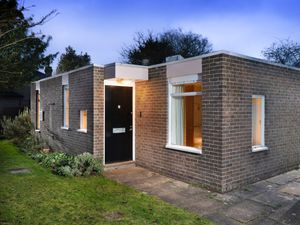Bungalow which was home to composer Imogen Holst protected with listed status
Holst also worked as an assistant to Benjamin Britten in Aldeburgh, Suffolk.

A bungalow where the composer Imogen Holst once lived has been protected with Grade II listed status.
Holst, who died in 1984 aged 76, was the daughter of the renowned composer Gustav Holst, who is best known for his seven-movement orchestral suite The Planets.
Imogen Holst was also a composer and for 12 years she worked as an assistant to Benjamin Britten in Aldeburgh, Suffolk.
In 1952, she was invited to help Britten as he worked on the opera Gloriana, marking the coronation of Queen Elizabeth II.

Holst accepted and she became Britten’s musical assistant, and later the artistic director of the Aldeburgh Festival.
She occupied a series of lodgings and rented flats in Aldeburgh until 9 Church Walk became her home.
The bungalow, designed by architects Jim and Elizabeth Cadbury-Brown, has been listed at Grade II by the Department for Culture, Media and Sport on the advice of Historic England.
The single-storey modernist home, built from 1962 to 1964, was designed for Holst and constructed on land owned by the Cadbury-Browns.

Her rent consisted only of a crate of wine for the Cadbury-Browns at Christmas and a steady supply of Aldeburgh Festival tickets.
In thanking them for the house, Holst wrote of her “IMMENSE and perpetual gratitude for the loveliest house in the world”.
“I think of you both every night of the year and send blessings in your direction for having enabled me to get on with my work in such heavenly quiet and solitude and comfort,” Holst wrote.
She lived at 9 Church Walk until her death in 1984.

The house features innovative design elements including a soundproofed music room where Holst worked and thoughtfully positioned windows framing views of the parish church.
The property, now owned by the cultural charity Britten Pears Arts and available as a holiday rental, has many original features.
These include built-in shelving systems, curtains with recessed tracking, and Holst’s personal items such as her writing desk and coloured glass panel hung on the window in front of her desk to diffuse the sunlight.
The property also houses Gustav Holst’s oak music cupboard, where Imogen stored her father’s manuscripts.
The house is open to the public every year for Heritage Open Days.

Heritage minister Sir Chris Bryant said: “The significance of Imogen Holst’s home extends far beyond its status as an unassuming yet notable example of Jim Cadbury-Brown’s architecture.
“It was here at 9 Church Walk where some of the greatest musical minds of the 20th century converged, exchanged ideas and laid the foundations of the Aldeburgh Festival – now a cornerstone of British classical music in its 76th year.
“By listing this remarkable building, we preserve not only its architectural merit but also the rich legacy of Holst and her peers, ensuring their contributions continue to inspire generations to come.”
Duncan Wilson, chief executive of Historic England, said: “The listing of 9 Church Walk celebrates an architecturally significant modernist home and a significant piece of musical history.”





